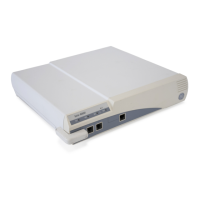2-20 Solar 8000M/i patient monitor 2026265-075C
Equipment overview: Theory of operation
Isolation – The TRAM-NET signals are electrically isolated with signal
transformers. The TRAM-NET power source is not isolated before being
delivered to the TRAM-NET network.
ESD protection scheme – The typical diode/transzorb pair is employed
to clamp the TRAM-NET connector pins to the common return plane.
Since the TRAM-NET is really not an electrically isolated network, the
need for maintaining isolation in the ESD protection scheme is not
present.
M-Ports (4)
ID signal – The ID Signal is generated using a Dallas Semiconductor 1-
Wire Line Driver chip, DS2480. The DS2480 is interfaced by the
MPC860's SCC3, which is multiplexed in the FPGA across the four (4) M-
Ports. The benefit of the DS2480 is that it relieves the MPC860 of doing
most of the timing for the interface to the 1-Wire memory device, such as
the DS2430 out in the DIDCA device. Also it improves noise immunity by
reading at the latest possible time and it minimizes emissions by driving
the line with a controlled edge rate and controlled drive current. The rate
at which the DS2480 can receive new commands or transfer additional
bytes of data is synchronized by the MPC860 waiting for a received
character interrupt response from the DS2480 before it can load the next
character. The ID signal has its own Return line. The ID Signal and its
Return share the RJ-45 connector pins that the M-Port Ethernet 10 Base
T Transmit differential pair uses. The functionality of the shared
connector pins is determined by a relay under software control.
RS-232/UART interface – The M-Port RS-232 interface is provided by
a Philips SC28L194 Quad UART (one UART per M-Port) and an Analog
Devices ADM202E RS-232 Driver/Receiver. The SC28L194 Quad UART
has sixteen (16) byte FIFO's on both the receiver and transmitter and I/O
port pins that function as status LED drive signals. The benefit of the
FIFOing is to reduce the overhead to the MPC860 to service the UART's.
The Quad UART uses the auto vectored interrupt on level 3.
Ethernet facility – A Broadcom Ethernet Switch provides each M-Port
with Ethernet capability. With the relay in the Ethernet position, pins 3
and 6 in the RJ-45 connector provide the Ethernet Differential Transmit
pair. The Ethernet receive pair are provided on pins 1 and 2 of the RJ-45
connector.
NOTE
The M-Port provides Host or Hub pinouts, not device side pin outs, so
that a one-to-one Category 5 cable can be used to connect any
Ethernet device up using an M-Port.

